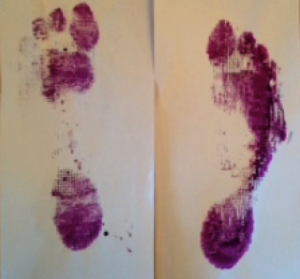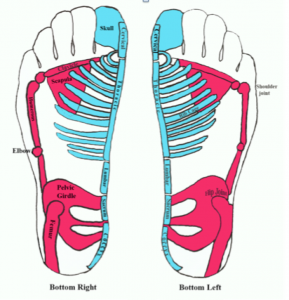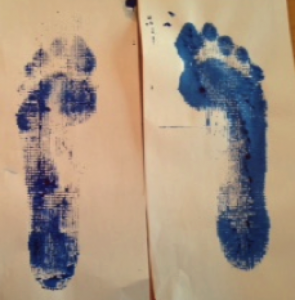When someone makes an appointment for Structural Reflexology® they are seeking relief from foot pain.
Each structural reflexology session begins with a foot assessment. Signs of stress are evident when the feet present areas of calluses, redness, puffiness and bunions to name a few. Most people don’t understand how their feet work–or have an idea how their feet have gone awry. In order to educate clients on foot function I sometimes use an ink press to demonstrate how their feet bear weight while in motion. The results can explain where their feet have become weak and how this weakness may be affecting other parts of their body. The desirable imprint will show weight placed on the outer column of the foot with each toe visibly bearing equal weight (see blue ink press image of right foot below). When the foot becomes stressed the muscles that lift, place, and propel the foot lose their functional ability to direct weight and the imprint will reveal this impact of undue burden (as shown in the pink ink press).


My drawing of the skeletal system as a microcosm within the feet.
The image on the left in pink is an ink press imprint of the bottom of the left and right foot in motion of a 63 year old woman. Each imprint is done one foot at a time.
The image in blue below shows a stronger weight bearing arrangement of the right foot of a another individual. The left foot developed a foot problem which shows tentative weight placement.
Let’s focus on the pink colored foot impressions. Notice how the left foot reveals the weight of this individual being placed mostly on the inner column of her foot while the outer column of this same foot reveals a ghostly impression of weight. As a reflexologist and taking local foot anatomy and physiology into account, this imprint is telling of the structural challenges her body faces in her left hip, throughout her back, and in her left shoulder because the areas of her foot that support these parts of the body have weakened and therefore, are not available to stabilize her side-body. This individual’s left shoulder posture would depreciate by rolling forward because of the unstable base beneath. Other symptoms that may fester include digestive issues, cramping in the diaphragm muscle (hiccoughs) and, quite possibly, hearing issues.
The right foot ink press image in pink displays a slightly healthier foot than her left, however her fourth and fifth toes are not visible on the impression. Even though she is bearing weight on the appropriate outer column of this foot, its placement is slight, and the foot is hyper-supinating, or tipping side-ways on the outer foot. The ball beneath her right great toe barely touches down, confirming strain in the the muscles needed to engage the transverse arch to direct weight to the toes. This in turn will minimize the reflex activity to the chest area which will become under stimulated- especially affecting the deeper tissue of the lungs, and over-stimulating the hip and knee reflexes.
Together these imprints show an individual struggling to move, because one foot, her left, leans inwardly, and the right foot leans outwardly. Her right foot is chronically leaning to the right, and her fourth and fifth toes which would normally receive weight are not available (too weak) to participate in relieving this load. The imposition of her foundation causes strain in her right hip and knee when she walks because her left foot pushes her weight toward the right side of her body– and because of this, her right foot struggles to balance and direct weight. Previous to this session, this individual had 3 knee replacement surgeries.
After one’s feet are assessed, the individual receives a full reflexology session, integrating muscle and joint release work to relieve strain in the feet. Once the muscles that move each foot are relaxed, sites of ligament injury are usually uncovered and therapeutic techniques are then applied to help heal the traumatized ligament(s). Subsequently, this relaxing effect on the joint structure of the feet allows the lateral (weight bearing) and medial (spring and shock absorber) columns to normalize and maintain their functional position to bear weight comfortably.
Happily, this person won back healthy foot function with structural reflexology and has repeatedly expressed her deep gratitude for regaining not only strength and vitality in her feet, but in her entire body– stating “My quality of life has changed dramatically for the better!”
Archives
- October 2024
- December 2023
- October 2023
- March 2022
- July 2021
- August 2020
- May 2020
- April 2020
- February 2020
- January 2020
- December 2019
- November 2019
- October 2019
- August 2019
- June 2019
- May 2019
- April 2019
- January 2019
- December 2018
- October 2018
- September 2018
- July 2018
- June 2018
- April 2018
- February 2018
- December 2017
- November 2017
- October 2017
- September 2017
- August 2017
- July 2017
- June 2017
- May 2017
- April 2017
- February 2017



One Response to What is it like to receive a Structural Reflexology session?